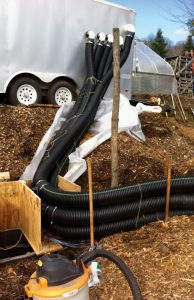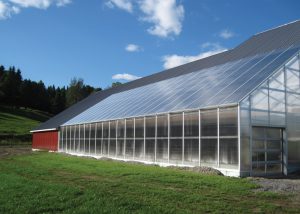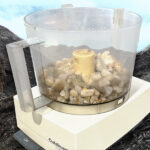Two Vermont enterprises are using heat from active composting piles — up to 1 million Btus of energy per ton of material composted — in greenhouse operations this winter.
Gaelan Brown
BioCycle March/April 2015
The heat from active composting piles is being put to work in greenhouse operations this winter at two Vermont enterprises. Jasper Hill Farm in Greensboro, and Vermont Compost Company in Montpelier, are each heating greenhouses through Vermont’s harsh winter with up to 1 million Btus of energy per ton of material composted, saving thousands of dollars on heating and hot water fuel, and extending the vegetable growing season.

A “plug and play” Compost Heat Wagon, operating this winter at Vermont Compost Company, includes a high power aeration fan and an Isobar™ heat recovery system.Photo courtesy of Agrilab Technologies
Recent advances in compost heat recovery are the result of many years of research and collaboration between organizations like Highfields Center for Composting, CompostPower.org, Yestermorrow Design/Build school, Agrilab Technologies, Acrolab Ltd, City Soil, Vermont Compost Company, SUNY Cobleskill and the Universities of Vermont and New Hampshire, among others.
The keys to success have been new methods of managing aeration, combined with innovative heat exchangers. Negatively aerated static pile systems (pulling air down through the top of the material into channels underneath it) enable heat to be captured by running the hot vapor pulled from the compost through a heat exchanger. Negative aeration also enables capture of carbon dioxide (CO2) emissions and odors from compost. Vermont-based Agrilab Technologies and Acrolab, LTD in Canada developed the patented process with negative aeration and heat exchangers for compost heat recovery systems like the ones at Jasper Hill Farm and Vermont Compost Company.
Jasper Hill Farm
Jasper Hill Farm maintains a herd of about 50 Guernsey cows, using the milk in award-winning craft cheese production. The farm began composting manure, bedding and refusal feed (left over hay) in 2012. The aerated composting and compost heat recovery system is one component of the farm’s integrated “Green Machine,” which also includes manure solids separation, a small anaerobic digestion system and liquid residuals treatment through subsurface gravel wetland cells. The farm pursued this biological system approach after the cheese processing residuals and other liquids overwhelmed the previous leach field systems with their shallow soils and ledge outcrops.
Seven roof-covered concrete composting bunkers with aeration channels were built along the north side of a building that has a greenhouse and mechanical rooms on the south side. Each bunker holds up to 40 tons of material and is separated by concrete walls. The 140° to 160°F compost vapor exhaust is pulled down into the aeration channels in the pad by a single aeration fan. Simple pneumatic valves and timers control which bunker is aerated at any given time, providing 30,000 to 40,000 Btus/hr whenever the aeration system is operating. The Isobar™ heat exchanger transfers the heat in the compost vapor into a 400-gallon water tank.
Hot water from the tank is circulated to the anaerobic digestion tanks to aid in temperature balancing. Liquid manure, whey and washwater enter the digester tanks at around 55°F and need to be brought up to 101°F for the mesophilic anaerobic digestion process. Depending on the temperature of the incoming vapor, fan speed and the water in the exchange tank, the vapor temperature from the compost heat recovery system can drop by 10° to 40°F (from the initial 140° to 150°F going into the system.
Exhaust from the compost heat recovery system can be directed outdoors or into a simple biofilter inside the greenhouse, so that the CO2 emissions in the compost vapor feed the plants while the compost odors, primarily ammonia, are scrubbed. This reduces the amount of cold fresh air that must be brought into the greenhouse for CO2 replenishment, reducing the amount of energy needed to heat the greenhouse.
The biofilter designed for Jasper Hill is a thick layer of finished compost placed over perforated pipes. The biofilter is directly under the seedbed soils in the greenhouse. During the first winter of operation, seedbeds were kept in the range of 70° to 90°F from the heat remaining in aeration system exhaust. Moisture from the exhaust also goes into the soil, reducing watering needs. The biofilter requires monitoring for temperature, moisture and back pressure, and some fine-tuning depending on the situation. Biofilters can be sized smaller and last much longer when the compost aeration exhaust that is vented into them has been cooled off by a compost heat recovery system.
When ammonia in the exhaust touches the soil, it converts to ammonium, a form of nitrate that bonds to the soil so plants can use it. When too much ammonia enters the soil, or the biofilter becomes saturated, ammonia odors can enter the greenhouse, which can become toxic for the plants. Therefore this approach to biofiltration in greenhouses needs to be done carefully. The controlling factors in the biofilter are the available carbon in the wood chips and mature compost biofilter bed, as well as maintaining mesophilic temperatures. The odor-controlling microbes are best suited for temperatures below 110°F.
Vermont Compost Company
Agrilab Technologies’ mobile heat recovery system, the Compost Heat Wagon, is now running at the Vermont Compost Company (VCC), owned by Karl Hammer. It is a space efficient, “plug and play” style compost aeration and Isobar® heat recovery system that includes a high power aeration fan with variable speed drive and computerized controls, data monitoring, condensate collection and the condenser heat pipe heat exchange system that makes hot water. This water is used for space heating, plant irrigation or washing. Unlike Jasper Hill Farm, which has aeration channels cast into a concrete slab floor (compost production pad) with pipes and condensate/leachate traps, Hammer’s team and Agrilab Technologies customized a nonpermanent aeration system into a thick base of wood chips next to the Compost Heat Wagon and greenhouse.

Jasper Hill Farm’s compost heat recovery system pulls 140° to 160°F compost vapor exhaust into a heat exchanger that transfers the heat into a water tank. Hot water is circulated to heat anaerobic digestion tanks. Exhaust from the heat exchanger is directed to a biofilter in the greenhouse that is built under the seedbeds.
Photos courtesy of Agrilab Technologies
On this project, the compost vapor exhaust from the Isobar® heat exchanger is vented into a perforated pipe buried in the top of the compost pile. This recirculates the wet compost vapor back into the pile, enabling increased aeration and heat recovery without the compost drying out too quickly. As food scraps are part of the compost mix along with manure and shredded bark, Hammer wanted to have a means to filter potential odors from the aerated batches.
Hot water from the Isobar® heat exchanger is circulated from the Compost Heat Wagon to two 350-gallon tanks in VCC’s greenhouse. The compost pile comprised of 100 tons of material has four separate 25-ton aeration zones. Up to 25,000 Btus/hr are captured in terms of hot water that is sent to the greenhouse water tanks. Heat loss from the tanks adds warmth to the greenhouse and water from those tanks is circulated into radiant heated seedbeds and irrigation lines. The primary use of the greenhouse is for compost and potting soil mix germination testing and bioassays. Quality control is crucial for VCC’s products and its greenhouse grower clientele. The greenhouse is also used for growing vegetables for VCC staff. Additional greenhouse production is being planned for fall 2015.
System Paybacks
No information has yet been released by Jasper Hill Farm on the total capital cost of its overall project, or the farm’s return on investment. This information will be available as part of a final project report to funding agencies that include the U.S. Department of Agriculture and the Vermont Agency of Agriculture, Food & Markets. The Isobar® heat exchanger components on this site cost $39,000. The compost heat recovery system at Jasper Hill Farm captures between 30,000 and 40,000 Btu/hr from the series of 40-ton compost piles that are actively aerated. This amount of energy is worth up to $10,000/year if this energy is valued at $30/million Btu, which is historic average cost of propane or fuel oil.
The Compost Heat Wagon at VCC retails for $55,000. The unit has been in place to test integration on this site and provide VCC experience with negative aeration using relatively small batch sizes. The company plans to use the Compost Heat Wagon in Fall 2015 with larger batch volumes on its primary compost working pads. The aeration and heat recovery project will have a payback projection once completing the next phase of design this summer. For the current project, VCC is paying Agrilab Technologies for use of the system under a “power purchase” style arrangement, paying for the Btus captured at market rates.
Gaelan Brown is Vice President of Sales and Marketing, for Agrilab Technologies, founder of the Compost Power Network and author of the book, “The Compost Powered Water Heater.” For more information about compost heat recovery, visit www.compostpower.org, www.agrilabtech.com.














